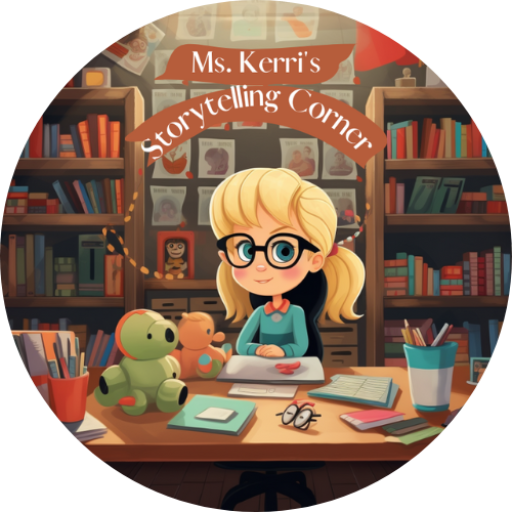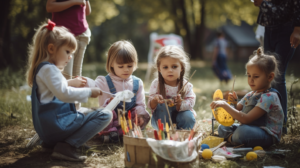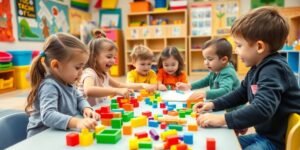Open-ended art is a valuable educational tool that offers numerous benefits to children. By encouraging creativity, problem-solving skills, and self-expression, open-ended art helps children develop important skills that will benefit them throughout their lives. In addition, messy art provides opportunities for fine motor skill development, enhances cognitive development, and builds resilience and perseverance. Creating a supportive environment that provides materials, embraces mistakes, and offers guidance is essential for fostering the educational benefits of open-ended art. Incorporating open-ended art in education can be done by integrating art into different subjects, engaging in collaborative art projects, and assessing artistic growth and progress. In summary, open-ended art is a powerful educational tool that promotes holistic development and should be embraced in educational settings.
Key Takeaways
- Open-ended art fosters creativity and imagination
- Open-ended art encourages problem-solving skills
- Open-ended art promotes self-expression and confidence
- Messy art develops fine motor skills
- Messy art enhances cognitive development
Why Open-Ended Art Matters

Fostering Creativity and Imagination
Open-ended art is a powerful tool for fostering creativity and imagination in children. Unlike structured art activities that have predetermined outcomes, open-ended art allows children to explore their own ideas and express themselves freely. This type of art encourages children to think outside the box and come up with unique solutions to artistic challenges. It also helps them develop their imagination by allowing them to create their own stories and worlds through art. By engaging in open-ended art, children are able to tap into their creative potential and develop a sense of wonder and curiosity about the world around them.
Encouraging Problem-Solving Skills
Encouraging problem-solving skills is a crucial aspect of open-ended art. When children engage in open-ended art activities, they are presented with various challenges and obstacles that require them to think critically and find creative solutions. This process of problem-solving helps them develop important cognitive skills such as logical reasoning, spatial awareness, and decision-making. By experimenting with different materials and techniques, children learn to adapt and adjust their approach to achieve their desired outcome. Problem-solving in open-ended art also encourages children to think outside the box and explore unconventional solutions, fostering their ability to think creatively and innovatively.
Promoting Self-Expression and Confidence
Promoting self-expression and confidence is a key aspect of open-ended art. When children are given the freedom to explore their own ideas and express themselves through art, they develop a sense of ownership and pride in their work. This process allows them to discover their unique voice and build confidence in their abilities. Through open-ended art, children learn that there is no right or wrong way to create, and that their ideas and perspectives are valuable.
The Benefits of Messy Art

Developing Fine Motor Skills
Engaging in open-ended art activities is a fantastic way for children to develop their fine motor skills. By using various art materials such as paintbrushes, markers, and clay, children are able to practice their hand-eye coordination and strengthen their hand muscles. Fine motor skills are essential for everyday tasks such as writing, buttoning clothes, and tying shoelaces. Through open-ended art, children can improve their dexterity and precision, which will benefit them in various aspects of their lives.
Enhancing Cognitive Development
Engaging in open-ended art activities can have a profound impact on cognitive development in children. When children are given the freedom to explore and create without strict guidelines or predetermined outcomes, their brains are stimulated in unique ways. Problem-solving and critical thinking skills are honed as children navigate through the creative process, making decisions and finding solutions along the way. This type of art also encourages children to think outside the box, fostering innovative and imaginative thinking.
Building Resilience and Perseverance
Building resilience and perseverance is a crucial aspect of open-ended art. When children engage in messy art activities, they are faced with challenges and obstacles that require them to persist and find solutions. This process helps them develop resilience, the ability to bounce back from setbacks, and perseverance, the determination to keep going even when things get tough. Resilience and perseverance are important life skills that can benefit children in various aspects of their lives.
Creating a Supportive Environment

Providing Materials and Tools
When it comes to open-ended art, providing the right materials and tools is essential. Variety is key, as it allows children to explore different textures, colors, and mediums. From paintbrushes and markers to clay and collage materials, offering a wide range of options encourages creativity and experimentation. Additionally, having accessible materials ensures that all children can participate and express themselves artistically. Whether it’s providing adaptive tools for children with disabilities or offering alternative materials for those who may not be comfortable with traditional art supplies, inclusivity is important in fostering a supportive environment for open-ended art.
Embracing Mistakes and Failure
In the world of open-ended art, mistakes and failure are not only accepted but embraced as valuable learning opportunities. Children are encouraged to explore and experiment without the fear of making mistakes. This fosters a growth mindset, where they understand that mistakes are a natural part of the creative process and can lead to new discoveries and innovative solutions.
Instead of focusing on the end result, open-ended art emphasizes the process and the journey of creating. It teaches children that there is no right or wrong way to create art, and that their unique ideas and perspectives are valuable.
By embracing mistakes and failure, children develop resilience and perseverance. They learn to overcome challenges and setbacks, and to keep trying even when things don’t go as planned. This resilience extends beyond the art studio and into other areas of their lives, helping them navigate through difficulties and find creative solutions.
In open-ended art, mistakes are not seen as failures, but as opportunities for growth and learning. Children learn to embrace the unexpected and to see mistakes as stepping stones towards new possibilities and discoveries. This mindset fosters a sense of curiosity, adaptability, and a willingness to take risks in their artistic endeavors and beyond.
Offering Guidance and Inspiration
When engaging in open-ended art activities, it is important for educators to provide guidance and inspiration to students. Guidance can come in the form of suggesting different techniques or materials that students can explore. By offering suggestions, educators can help students expand their artistic skills and knowledge. Additionally, educators can provide inspiration by sharing examples of artwork or discussing famous artists. This can spark students’ creativity and encourage them to think outside the box.
Incorporating Open-Ended Art in Education

Integrating Art into Different Subjects
Integrating art into different subjects is a powerful way to enhance learning and engage students in a creative and interactive way. By incorporating art into subjects like math, science, and history, students are able to make connections between different disciplines and deepen their understanding of the material. Art allows students to explore concepts and ideas in a visual and hands-on way, making learning more tangible and memorable. It also provides an opportunity for students to express their unique perspectives and interpretations, fostering creativity and critical thinking skills.
Collaborative Art Projects
Collaborative art projects are a fantastic way to promote teamwork and cooperation among students. By working together on a shared artistic endeavor, students learn valuable skills such as communication, compromise, and problem-solving. Collaboration allows students to bounce ideas off each other, sparking creativity and expanding their artistic horizons.
In a collaborative art project, students can take on different roles and responsibilities, fostering a sense of ownership and pride in their work. They can divide tasks such as sketching, painting, and adding details, ensuring that everyone contributes to the final masterpiece. This not only enhances their artistic skills but also teaches them the importance of working together towards a common goal.
To facilitate collaboration, teachers can create a supportive environment where students feel comfortable sharing their ideas and opinions. Encourage open communication and active listening, allowing students to express their thoughts and provide constructive feedback. This helps build trust and respect among students, creating a positive and inclusive atmosphere for collaborative art projects.
In addition to promoting teamwork, collaborative art projects also provide an opportunity for students to learn from each other. They can observe different techniques and styles, inspiring them to try new approaches and expand their artistic repertoire. By working together, students can learn from their peers’ strengths and support each other in areas where they may need improvement.
Tip: When assigning collaborative art projects, consider mixing students with different skill levels and backgrounds. This diversity can lead to a richer and more dynamic creative process, as students learn from each other’s unique perspectives and experiences.
Assessing Artistic Growth and Progress
Assessing artistic growth and progress in open-ended art can be a challenging task. Unlike traditional art forms with specific techniques and outcomes, open-ended art focuses on the process rather than the end result. It encourages children to explore their creativity and express themselves freely. Observation is a key tool in assessing artistic growth and progress. By observing children’s engagement, experimentation, and problem-solving skills during the art-making process, educators can gain valuable insights into their artistic development.
Incorporating open-ended art in education is a powerful way to foster creativity and critical thinking skills in students. By providing opportunities for students to explore their own ideas and express themselves through art, we can encourage them to think outside the box and develop their own unique perspectives. Open-ended art allows students to engage in self-directed learning, where they can make choices, solve problems, and take ownership of their creative process. It also promotes collaboration and communication, as students can share their ideas and learn from each other. If you’re looking to inspire your students and enhance their learning experience, visit Ms. Kerri’s Story Telling Corner, where you’ll find a wide range of resources and activities to incorporate open-ended art in your classroom. Click here to explore the possibilities!
In Conclusion
In conclusion, open-ended art is not just messy, it is also incredibly beneficial for education. By allowing children to explore their creativity without limitations, they develop important skills such as problem-solving, critical thinking, and self-expression. Messy art encourages experimentation and risk-taking, fostering a growth mindset and a love for learning. So, the next time you see your child covered in paint or glue, embrace the mess and know that they are gaining valuable educational experiences.
Frequently Asked Questions
What is open-ended art?
Open-ended art refers to the process of creating art without specific guidelines or predetermined outcomes. It allows individuals to explore their creativity and express themselves freely.
Why is open-ended art important for children?
Open-ended art is important for children as it fosters creativity, imagination, problem-solving skills, self-expression, and confidence. It allows them to think outside the box and develop a sense of autonomy in their artistic expression.
How does open-ended art develop fine motor skills?
Open-ended art activities often involve using various art materials such as paintbrushes, crayons, scissors, and clay. These activities require precise hand movements and coordination, which help develop fine motor skills.
What cognitive benefits does messy art provide?
Messy art engages multiple senses and stimulates brain development. It enhances cognitive skills such as problem-solving, critical thinking, spatial awareness, and decision-making.
How can educators incorporate open-ended art in different subjects?
Educators can incorporate open-ended art in different subjects by integrating art projects that relate to the topics being taught. For example, students can create visual representations of scientific concepts or historical events.
How can parents support open-ended art at home?
Parents can support open-ended art at home by providing a variety of art materials, encouraging creativity, displaying and appreciating their child’s artwork, and engaging in art-related discussions and activities.


Ms. Kerri’s Corner provides a exciting virtual space for preschool learning. Through a variety of engaging activities, she exposes young minds to early math, literacy, science and social-emotional skills in a developmentally appropriate way. Centers for blocks, art, books and music allow children to explore hands-on learning at their own pace. Guided lessons subtly introduce number sense, letter sounds and narrative thinking. Careful observation gives insight into each child’s progress across domains. Viewers are also invited to participate, reinforcing that their ideas are valued. By making learning fun yet purposeful, Ms. Kerri lays the groundwork for future academic success while fostering creativity and imagination. Her program offers preschoolers valuable screen-based learning experiences.






